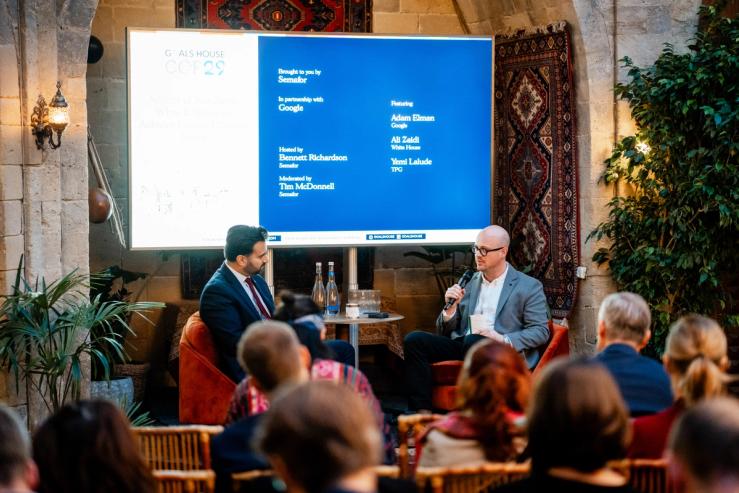The News
Billions of dollars of investment in US clean tech factories could be stranded if the incoming Trump administration pares back the country’s climate policies, outgoing President Joe Biden’s national climate adviser told Semafor.
Speaking on the sidelines of COP29, Ali Zaidi said the clean energy buildout in the US is unlikely to slow down under the new administration, and that companies and local governments can keep the US involved in global climate talks even if Trump walks away from them. But he warned that domestic manufacturing, in particular, is at “a fragile inflection point” and that the changes to climate policy could cut new investments short.
In this article:
Tim’s view
Manufacturing is one of the big success stories of the Inflation Reduction Act, the Biden administration’s landmark clean tech spending program. Since the law was passed, factories for building things like EV batteries and solar panels have drawn at least $89 billion in investment. The completion of all announced manufacturing projects would create more than 100,000 jobs, according to the advocacy group E2. Most of that investment is in Republican congressional districts, meaning the tax credits helping to drive it forward should be fairly well protected from reversal next year.
But there are other factors that could leave future clean tech manufacturing investment in doubt. The Federal Reserve may move more slowly to lower interest rates if some of Trump’s planned policies around immigration, cutting taxes, and raising tariffs drive inflation back up — a persistently strong economy already has traders paring bets on rate cuts in December. The new administration may also slow down the flow of Department of Energy grants and loan guarantees, which are a critical lifeline for some new factories. And Zaidi warned that jobs could be lost in traditional manufacturing sectors like steel if the next administration doesn’t take steps to help those factories bring their emissions in line with the tightening standards of their customers in Europe. A new European Carbon Border Adjustment Mechanism will impose penalties on imported carbon-intensive steel in particular. Zaidi’s concerns are backed up by a report this week from Johns Hopkins University researchers, who found that walking back US climate policies would divert at least $80 billion in future manufacturing investment away from the US to Europe, China, and other markets.
On the issue of US credibility at future COP summits under Trump, not everyone is as sanguine as Zaidi about the ability of states and companies to keep up the pace. Chile’s Environment Minister Maisa Rojas told Bloomberg that US leadership will be sorely missed if Trump proceeds with pulling out of the Paris Agreement. And Racquel Moses, who represents a coalition of Caribbean island states, told Semafor that backing out of future COPs will only hurt the US economy. “The countries that have been the most successful are the ones who have a long-term plan,” she said. “So I hope that [the Trump administration] come to their senses and realize that this sort of confusion isn’t good for them and it’s not good for everybody else.”
The View From Baku
This interview has been edited for length and clarity.
Tim McDonnell: John Podesta, the top US representative at COP29, told reporters this week that the election outcome was “obviously bitterly disappointing” and that other countries are getting frustrated by the in-and-out nature of US climate action. How do you maintain trust with the other people at this conference?
Ali Zaidi: The US has been able to build up a great deal of credibility over the last four years because of our efforts. A second aspect of this is you’ve got one of the largest emitters in the world with a very robust civil society, with states and local governments that regularly show up in dialogues like this one, and a private sector that has spotted the massive economic opportunity embedded in climate action.
So you think the US is still credible even though most likely it will have pulled out of the Paris Agreement by the time of next year’s COP?
I don’t want to sugar-coat the fact that we will likely have a federal government that is not interested in engaging in this dialogue, let alone in leading on it. That’s deeply problematic, and it comes to the detriment of US business interests and US workers. But I fully expect US civil society, states, and our private sector to show up in Brazil. It would be economic malpractice not to show up when the rules are being written.
Is that part of your work here in Baku, to kind of oversee the buildup of that coalition between US sub-national groups and other countries?
Other countries are very eager to grab the baton. Climate change is not going to pause because of an election in the US. The race to lead the global clean energy sector is not going to pause because the US decided that it didn’t want to put its full weight behind winning. But inherent in the structure of President Biden’s climate strategy was the federal government coming in as the booster on a rocket, which is the private sector. And in a lot of sectors we have achieved escape velocity, and the private sector will continue to carry us in the right direction.
Looking at the next four years, which areas are you most concerned about?
We’re at a fragile inflection point in American manufacturing. We have started to write a comeback story, but that comeback could get cut short if Washington pulls the plug on American manufacturing. But are we going to see this transformation through, or are we going to leave an unfinished picture? That keeps me up at night. The second place is the agricultural sector. We have been able to reach 80,000 farmers and ranchers with the promise of climate-smart agriculture, and they now have a new [carbon] revenue stream on their books that rewards them for the benefits they’re delivering to the market and the environment. But what was indicated in the House-passed farm bill this year is to pull the rug out.
The third area I’m anxious about is you have the whole world now racing towards an understanding on the embodied carbon in materials. The European carbon border adjustment comes online in 2026. If the US does not lean into that, our steel, aluminum, cement and other heavy industries will get left behind, and that’s deeply problematic. I’m also nervous about communities that need the federal government to respond to impacts we’re seeing from climate change, whether it’s the flood risk, hurricanes, wildfires, or extreme heat. They don’t have the luxury of deciding whether they believe in climate change or not.
What’s on your to-do list for the rest of the term?
Our goal is to make sure that all of our investment agenda gets into the economic bloodstream. Nine out of every $10 in our investment agenda, on the grant side, has hit the road. We want to make sure the rest of it gets there.
Are we going to get final rules for the 45V hydrogen tax credit?
Whether it’s hydrogen or our tech-neutral tax credits, we will be able to get additional clarity and clarification into the market. The goal here is to lay out the regulatory certainty that facilitates capital formation.
Were there any climate goals that you feel after four years you didn’t get to accomplish?
The work on climate change is not done until we’ve achieved net zero emissions economy-wide. It’s really that simple. So it’s a multidecade effort that involves everybody. But we’ve shifted the paradigm on climate from one that was predicated on sacrifice, to one that’s very clearly about economic opportunity, and if we stay there, we’ll get all the way to net zero.


